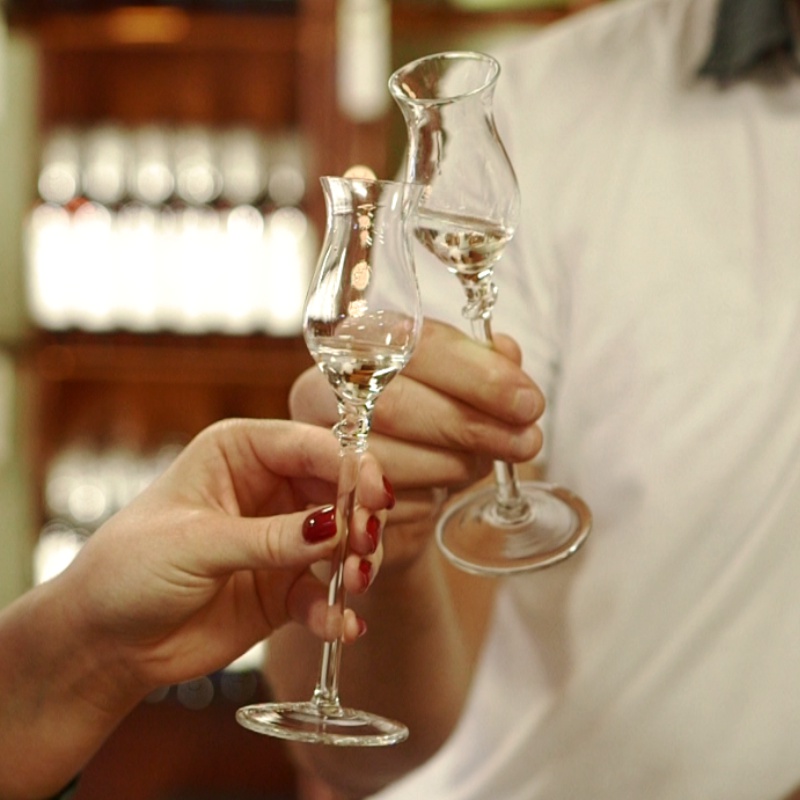The Scents of Grappa
Floral Scents
This group of scents is really vast, ranging from white flowers to red ones, to the intense expressions of tropical flowers. Think, for example, of the wonderful scents of an aromatic Grappa made from Moscato grapes, so rich and delicate in its scents of white flowers, reminiscent of spring blooms. But in Grappas, you can also encounter scents of lilac, lily of the valley, and rose. They are all very recognizable scents that give the distillate a unique and wonderful gentleness.
Fruity Scents
If the group of floral scents was vast, fruity scents are perhaps even more present. Especially in young and aromatic Grappas, you can find splendid hints of apple, peach, strawberry, and whatever else our ability is able to recognize. If we just keep in mind that Grappa is the distillate of grape pomace, so rich in aromas, we can understand how many essences can be contained in a glass of Grappa. So, we will also encounter scents of dried fruit, apricots, perhaps we will discover scents of exotic fruits like banana or pineapple, present in Grappas aged for a long time in wood.
This group of scents is really vast, ranging from white flowers to red ones, to the intense expressions of tropical flowers. Think, for example, of the wonderful scents of an aromatic Grappa made from Moscato grapes, so rich and delicate in its scents of white flowers, reminiscent of spring blooms. But in Grappas, you can also encounter scents of lilac, lily of the valley, and rose. They are all very recognizable scents that give the distillate a unique and wonderful gentleness.
Fruity Scents
If the group of floral scents was vast, fruity scents are perhaps even more present. Especially in young and aromatic Grappas, you can find splendid hints of apple, peach, strawberry, and whatever else our ability is able to recognize. If we just keep in mind that Grappa is the distillate of grape pomace, so rich in aromas, we can understand how many essences can be contained in a glass of Grappa. So, we will also encounter scents of dried fruit, apricots, perhaps we will discover scents of exotic fruits like banana or pineapple, present in Grappas aged for a long time in wood.
Vegetal and Herbaceous Scents
This group of scents is very particular and not always easy to recognize. The scent of freshly cut grass or aromatic herbs comes directly from the grape pomace. It is easy to encounter them, for example, in a Grappa obtained from Cabernet or Merlot grape pomace. Given the peculiarity of this group of scents, it is possible, once fixed in the head, to recognize them effortlessly, given their uniqueness.
Spicy Scents
These scents with their many nuances are present especially in the most evolved Grappas, those that have undergone wood aging. Everyone knows the sweetness of vanilla or cinnamon, also called sweet spices. In fact, the oxidative transformations that occur in the barrel favor the development of these very interesting scents, releasing the classic aroma of vanilla.
This group of scents is very particular and not always easy to recognize. The scent of freshly cut grass or aromatic herbs comes directly from the grape pomace. It is easy to encounter them, for example, in a Grappa obtained from Cabernet or Merlot grape pomace. Given the peculiarity of this group of scents, it is possible, once fixed in the head, to recognize them effortlessly, given their uniqueness.
Spicy Scents
These scents with their many nuances are present especially in the most evolved Grappas, those that have undergone wood aging. Everyone knows the sweetness of vanilla or cinnamon, also called sweet spices. In fact, the oxidative transformations that occur in the barrel favor the development of these very interesting scents, releasing the classic aroma of vanilla.
Other Scents
This is not a true category. There are very different and extremely pleasant scents of Grappa that go beyond common classifications. A Grappa aged for a long time in wood may present scents of tobacco leaf, but also cocoa and even licorice.
But at the same time, how not to perceive the ethereal scent of the noblest alcohol, which is very close to green geranium stems and hints of iodine and medicinal aromas.
Defects in Distillates
A quality distillate is, first of all, a distillate without defects, without negative organoleptic elements that could affect the perception of its positive characteristics.
However, sometimes we may come across Grappas that have some unpleasant surprises, some scents that are not very pleasant and that reveal a defect in the production of the distillate. Any visual (cloudiness, suspensions), olfactory (excessive pungency, smell of acetone, burnt, moldy, rotten eggs, sauerkraut, goat, wax, rancid, oxidized) or taste defects (sour, oily, bitter, acidic, metallic) are an indication of poor distillation as well as poor conservation of the raw material and irreparably prejudice the perception and possibility of appreciating the positive characteristics of the distillate.
But at the same time, how not to perceive the ethereal scent of the noblest alcohol, which is very close to green geranium stems and hints of iodine and medicinal aromas.
Defects in Distillates
A quality distillate is, first of all, a distillate without defects, without negative organoleptic elements that could affect the perception of its positive characteristics.
However, sometimes we may come across Grappas that have some unpleasant surprises, some scents that are not very pleasant and that reveal a defect in the production of the distillate. Any visual (cloudiness, suspensions), olfactory (excessive pungency, smell of acetone, burnt, moldy, rotten eggs, sauerkraut, goat, wax, rancid, oxidized) or taste defects (sour, oily, bitter, acidic, metallic) are an indication of poor distillation as well as poor conservation of the raw material and irreparably prejudice the perception and possibility of appreciating the positive characteristics of the distillate.


